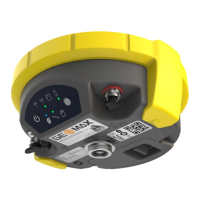☞
When using Pacific Crest GMSK protocol between a Zenith16/40 base and
Zenith16/40 rover, the Unit ID must be set to a different number for each receiver.
The latest version of the instrument firmware is available from the GeoMax website.
To update the instrument firmware, copy the respective file to the SYSTEM directory on a
microSD card and insert it into the GNSS receiver. Refer to "4.6 Insert a microSD Card".
At the Firmware upload menu the contents of the SYSTEM directory of the microSD card are
displayed. Choose the required file and click Upgrade to install the firmware onto the GNSS
receiver.
☞
After firmware is installed, the System RAM of the GNSS receiver must be formatted
by pressing and holding the keyboard buttons for 10 s. Refer to "3.1 Keyboard".
Optional GNSS receiver licences are activated with a key file. Before installing the licence key file
onto the GNSS receiver, ensure that a microSD card is inserted it into the GNSS receiver. Refer
to "4.6 Insert a microSD Card".
At the Upload menu browse for the key file on your computer and click Upload. A confirmation
message is shown once the option has been activated.
4.5 Batteries
4.5.1 Operating Principles
•
The battery must be charged prior to using it for the first time because it is delivered with
an energy content as low as possible.
•
The permissible temperature range for charging is between 0 °C to +40 °C/+32 °F to
+104 °F. For optimal charging we recommend charging the batteries at a low ambient tem-
perature of +10 °C to +20 °C/+50 °F to +68 °F if possible.
•
It is normal for the battery to become warm during charging. Using the chargers recom-
mended by GeoMax, it is not possible to charge the battery if the temperature is too high.
•
For new batteries or batteries that have been stored for a long time (> three months), it is
effectual to make only one charge/discharge cycle.
•
For Li-Ion batteries, a single discharging and charging cycle is sufficient. We recommend
carrying out the process when the battery capacity indicated on the charger or on a
GeoMax product deviates significantly form the actual battery capacity available.
•
The batteries can be operated from −20 °C to +55 °C/−4 °F to +131 °F.
•
Low operating temperatures reduce the capacity that can be drawn; high operating temper-
atures reduce the service life of the battery.
4.5.2 Insert and Remove the Battery
☞
The battery is inserted in the bottom part of the GNSS receiver.
1. Push the slide fastener of the battery compartment in the direction of the arrow with
the open-lock symbol.
Firmware upload
Upload key
Charging/first-time use
Operation/
discharging
Change battery
step-by-step
Operation 23

